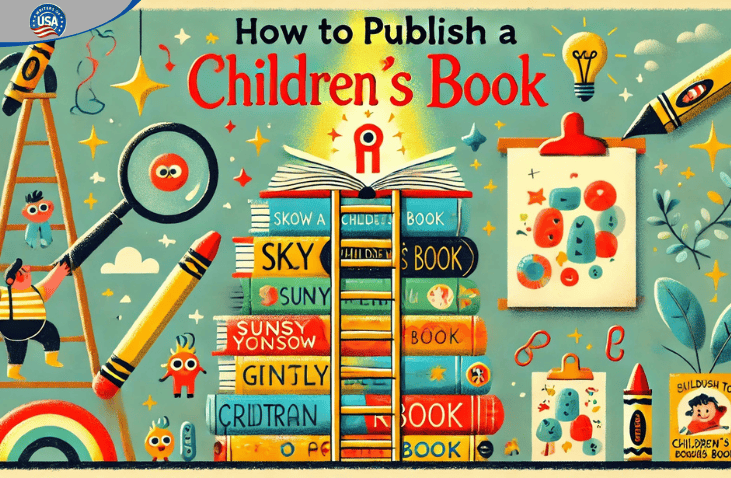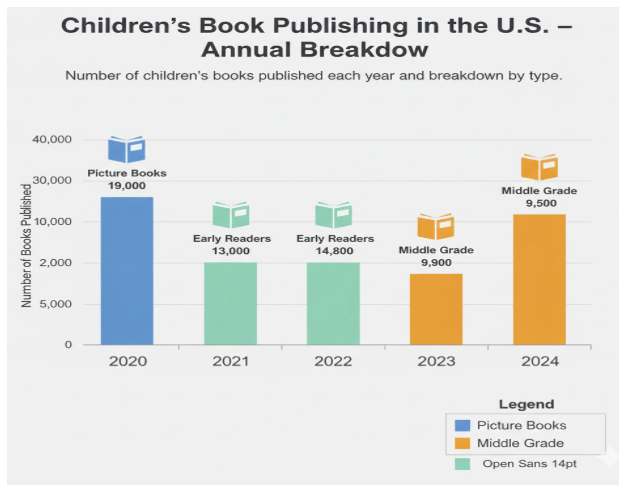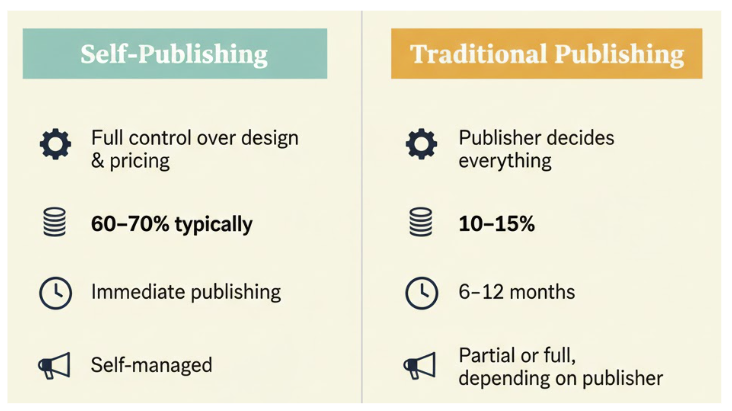Many people dream of writing for children, but figuring out how to publish a children’s book can feel overwhelming at first. There’s more to it than finishing a story — it’s about understanding how to turn your words into a real book that feels polished, professional, and ready for young readers. Every step matters, from illustrations and editing to learning how to publish children’s ebook on Amazon.
Publishing a children’s book is a rewarding journey. It’s not just about getting your work in print; it’s about creating something that might become a child’s favorite bedtime story or spark their imagination in new ways. Few creative projects offer that kind of lasting joy.
In this guide, you’ll find everything you need to know about how to publish children’s book. You’ll learn practical steps, insider tips, and real advice to help you move from idea to publication with clarity and confidence.
Getting Started: How to Publish a Children’s Book for the First Time
Before your story hits the shelves, understanding how to publish children’s book ensures your foundation is solid. Every successful publishing journey starts with the story itself. Let’s explore how to write, polish, and prepare your children’s book for the exciting steps ahead. If you’d rather not handle everything alone, learning how to outsource eBook writing can help you find professional support to make things smoother.
Writing Your Story: How to Publish a Children’s Picture Book or Chapter eBook
The writing stage is where your imagination truly takes off. Whether you’re writing a colorful picture book or a chapter eBook for older kids, knowing how to publish children’s book can guide your storytelling choices.
If you’re curious about the creative side of other writers, check out questions to ask an author about their book, it’s a great way to learn how others approach storytelling.
What Makes a Great Children’s Book?
Great children’s books are simple, meaningful, and memorable. They often use colorful language, vivid illustrations, and relatable themes like friendship, curiosity, or courage.
Keep in mind that steps to self-publish a children’s eBook begin long before publishing; it starts with writing a story that connects. Focus on a clear message and a structure that keeps kids turning pages.
How to Write a Children’s Book for Different Age Groups
Children’s books vary widely depending on age. For toddlers, short sentences and big, bold illustrations work best. For early readers, you can experiment with repetition, rhyme, and easy words. For older kids, add layers of humor or moral lessons through chapters and adventures.
Balancing work and writing can be tough, so if you’re trying to fit your creative passion into a busy schedule, how to write a book while working full time offers practical advice on staying productive without burning out.
A good rule of thumb: write with empathy. Think about what your readers, kids, and their parents will feel and remember long after they close the book.
Creating Your Manuscript: Steps to Self-Publish a Children’s eBook
Once your story idea is set, understanding how to publish children’s book will guide how you prepare your polished manuscript. This part may not be as colorful as the illustrations, but it’s the backbone of your entire book.
If you’re not confident in your writing or simply want professional help shaping your story, ebook ghostwriting services can help you bring your ideas to life while keeping your unique voice intact.
How Long Should a Children’s Book Be?
Word count plays a huge role in how your story reads. Picture books usually fall between 500 and 1,000 words, while chapter books can range from 5,000 to 15,000 words or more.
Keep it simple; kids have shorter attention spans, so clarity and rhythm matter more than long descriptions. If you’re planning how to publish a children’s eBook, aim for a clean, concise structure that fits your target readers’ age group. If you want more guidance on crafting your story, check out our tips on how to write a children’s book.
How to Organize Your Story
A great children’s story follows the classic beginning–middle–end flow. Start by introducing a problem, build tension through action or emotion, and end with a satisfying resolution that leaves readers smiling.
Professional editors or writing services can help fine-tune pacing and ensure the story feels natural. Explore children book ghostwriting services to find experts who understand how to structure and edit books for young audiences.
Once your manuscript feels right, you’re ready to move on to the visual part, which is crucial when preparing how to publish a children’s chapter ebook professionally.
Pre-Publishing Essentials: How to Publish a Children’s eBook on Amazon in 10 Minutes
Before uploading your book online, there’s a lot that happens behind the scenes, especially when you’re learning how to publish a children’s chapter ebook. From finding illustrators to formatting and proofreading, these steps ensure your book looks professional and reads beautifully.
Finding an Illustrator
Illustrations are the heart of most children’s books. They help readers connect instantly with the story, which is something to consider when learning how to publish a children’s book with Scholastic.
Why You Need an Illustrator for Your Children’s Book
Visual storytelling is what makes children’s books so special. Pictures capture attention, explain ideas, and make stories easier to follow. Without them, even the best story can feel flat to young readers. That’s why finding the right illustrator is one of the most important steps in publishing.
How to Find the Right Illustrator
Look for an illustrator whose style fits your story. Check portfolios carefully and see how they draw characters, emotions, and settings. You can find skilled childrens book illustrators for hire on platforms like Upwork and Fiverr, or through referrals from other authors. Once you find someone whose work you love, share your story, discuss ideas, and agree on the final vision before starting.
Editing and Proofreading
Every children’s book needs a little polishing before it’s ready to publish. Editing makes your story clear and fun to read for young audiences, which is a key step if you want to know how to publish a children’s picture book successfully.
Why Editing is Crucial in Children’s Book Publishing
Good editing keeps your story easy to follow and free of mistakes. It helps your ideas flow naturally and makes sure every line sounds right for children. Clear language and steady pacing hold their attention from start to finish.
Hiring a Professional Editor vs. DIY
You can hire childrens book editors who know how to fine-tune stories for young readers. They catch things you might miss and make your book sound professional. If you prefer editing yourself, tools like Grammarly can help fix small errors. You can also find experienced editors on Upwork or Reedsy who specialize in children’s books.
Book Design & Formatting: How to Publish Children’s eBook on Amazon Professionally
A strong design gives your children’s book its final polish. It’s what makes your story look professional and enjoyable to read.
How to Format Your Children’s Book for Print
Formatting keeps your pages clean and balanced, which is an important part of how to publish children’s book correctly. Use standard sizes like 8×10 inches, simple fonts, and enough margins for binding. For eBooks, Kindle Create on Amazon KDP makes layout setup easy. If you’re printing copies, custom children book printing services can guide you on paper and finish choices.
Designing a Professional Book Cover
Your cover is the first thing parents and kids notice, and it plays a key role when learning how to publish children’s book. Keep it bright, clear, and true to your story. Use Canva for simple designs or hire experts from Fiverr or Upwork who specialize in children’s book covers.
Legal Steps for How to Publish Childrens Book on KDP and Beyond
Before your book goes out into the world, make sure it’s legally protected and ready for sale. Let’s go over how to handle copyrights, ISBNs, and registrations, the official side of learning how to publish a children’s book for the first time.
Copyright and ISBN: Essential Steps to Publish a Children’s Book for the First Time
Copyrighting your book means your story is officially yours. It ensures no one else can copy, publish, or distribute your work without your permission.
How to Copyright Your Children’s Book
Copyrighting your story means it officially belongs to you. To register, visit the U.S. Copyright Office website, upload your manuscript, pay a small fee, and you’ll receive a confirmation once approved. This keeps your work safe from being copied or reused without permission.
Do You Need an ISBN for Your Children’s Book?
Yes, an ISBN is your book’s unique ID number. It helps bookstores, libraries, and online platforms list and track your book easily. Amazon KDP gives you one for free, or you can buy your own from Bowker if you want full ownership.
If you’d like a detailed breakdown of costs at each stage, check out how much does it cost to publish a book, which offers clear insights into budgeting for your publishing journey.
Registering Your Book with Libraries
Getting your book into libraries makes it easier for parents, teachers, and kids to find. It’s a simple step that can give your story a longer life and a wider audience.
How to Register Your Children’s Book with the Library of Congress
Once you have your ISBN, you can submit it to the Library of Congress or skip ahead to learn how to publish a children’s ebook on Amazon in 10 minutes for instant digital distribution. Just fill out a short form with your book’s details. When it’s accepted, your book is added to the national catalog, making it discoverable in libraries across the country.
If managing paperwork feels overwhelming, self book publishing guide can guide you through the registration process, helping ensure your book meets all cataloging standards.
Step-by-Step Guide: How to Publish Children’s eBook on Amazon
Once you’ve mastered the art of how to write short stories for Amazon, it’s now time to decide how to publish your book. Today, you can share your story with readers worldwide in just a few clicks by following the steps on how to publish childrens book on KDP. You can choose self-publishing or traditional publishing depending on your goals, budget, and timeline.
Self-Publishing VS. Traditional Publishing
Self-publishing lets you control every part of your book, and knowing how to publish childrens book on KDP makes the process much faster. You set the price, choose the design, and decide when it’s released. You also keep more of the royalties. Platforms like Amazon KDP and IngramSpark make it easy to publish worldwide.
Traditional publishing means working with a company that handles editing, design, and marketing. You get professional support but give up some creative control and royalties.
If you’re unsure, a self-publishing guide can help you weigh the options, and fiction book publishing services offer extra support for authors focusing on stories or long-form books.
To simplify your decision, here’s a quick comparison:
How to Publish a Children’s Book for the First Time on Popular Platforms
Several platforms make publishing your book easy, whether you want print copies, eBooks, or both. Choosing the right one depends on your goals, budget, and where you want your book to be available.
How to Publish Your Children’s Book on Amazon KDP
If you want to learn how to publish a book on Amazon, follow these steps:
- Create a KDP account at kdp.amazon.com
- Click “Create a new title” and choose Kindle eBook or Paperback
- Enter your book details: title, author name, description, keywords
- Upload your manuscript and illustrations
- Design or upload your book cover
- Set your price and choose royalty options
- Review your book and click Publish
Other Self-Publishing Platforms
Platforms like IngramSpark, Lulu, and Blurb make publishing simple, though many authors start with how to publish a children’s ebook on Amazon in 10 minutes for a fast and simple digital release. IngramSpark offers wide distribution and good print quality, but has setup fees. Lulu is easy to use for print and eBooks, but has a smaller reach. Blurb is great for visual books with flexible design tools, though its bookstore distribution is limited.
For authors working on longer stories, novel publishing services can provide extra guidance and support, helping with formatting, editing, and distribution.
To get noticed, keep your metadata and keywords consistent, ensure clean formatting and a strong cover, and promote your book through social media, newsletters, and author websites.
Marketing and Selling Your Children’s Book
Marketing your children’s book is about making it easy for parents, teachers, and kids to find your story. The better your marketing, the more readers will discover your book, and using top book marketing services can help people find it online more easily.
Marketing Your Children’s Book
Before diving into steps, remember that marketing is about connecting with the right audience and keeping them interested.
How to Market a Children’s Book
Use social media and email newsletters to share your book. Reach out to parents and educators who might enjoy your story. Make a simple content calendar to plan posts and track results. You can also contact influencers in the children’s book space for extra exposure.
How to Sell Your Children’s Book
Selling your book means making it available both online and in stores.
How to Get Your Children’s Book Into Bookstores
Talk to local bookstores and libraries. Many love to feature self-published books, especially if they teach lessons or values. Author publishing services can also help with retail distribution and getting your book in more stores.
Selling Your Children’s Book Online
Optimize your listing on Amazon KDP, Barnes & Noble, or other platforms. Use catchy titles, clear descriptions, and strong visuals. Price your book fairly so parents feel it’s worth it, and you still earn a profit. Whether you’re learning how to publish a children’s book with Scholastic, actively sharing and promoting your book is key to success.
Final Tips for Publishing Your First Children’s Book
From writing your story to picking the right illustrations and learning how to publish a children’s book for the first time, each step has its own place. You’ve explored how to prepare, print, and share your book through different publishing options. It might take a bit of patience, but every page you finish takes you closer to your goal. Keep learning through writing groups, online classes, and author events. Most of all, stay consistent and believe in your story. Every writer who made it started just like you—with a simple idea and the courage to see it through.




